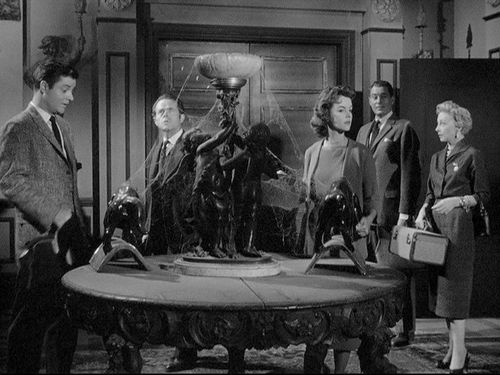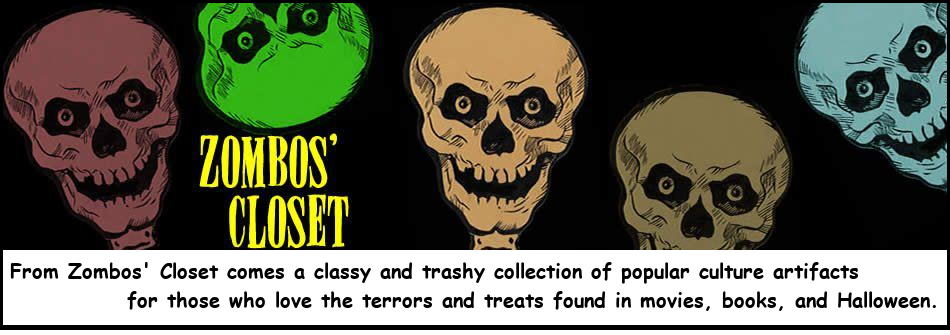
Zombos Says: Classic
In his book, Step Right Up! I’m Gonna Scare the Pants Off America, William Castle describes his chance meeting with a depressed Vincent Price in a coffee shop on a rainy evening. Price, melancholy over losing out on an important picture earlier that day, listens to Castle’s pitch on the role of the scheming millionaire Frederick Loren, who’s out to murder his wife.
“Sounds interesting,” he [Price] said. “Go on.”
“During the night, many strange ghostly things happen…blood dripping from the
ceiling…walls shaking…apparitions appearing. The millionaire—the part I
want you to play—has plotted to kill his wife. She plots to kill you…It’s a
battle of wits.”
Price smiled. “Who wins?”
“You do, of course. She tries to throw you in a vat of boiling acid.”
Price’s eyes gleamed. “How charming! I think I’ll have another piece of pie.”
Castle sums up by saying “the deal was made on the second piece of pie that same rainy night.”
While the 1940s had Universal’s iconic Monsters and RKO’s Val Lewton and Jacque Tourneur, the 1950s had William Castle’s spook show entertainment. Your ticket price guaranteed receipt of thrills and chills not only on the theater screen, but in the aisles as well. Realizing his B-movies—mostly written for a younger audience—needed a little something extra to generate buzz, Castle ramped up the marketing hype by using lurid
trailers, tawdry poster art, and clever—silly—gimmicks to hawk his movies. Like that wonderful prize you can’t wait to get to in a Cracker Jack Box, Castle’s gimmicks were always simple and sweet in effect, and perfect for the Saturday matinée crowd.
Whether it was the insurance policy handed out during Macabre, or Percepto tingling your theater-seated butt in The Tingler, or squinting through Illusion-O glasses to see all Thirteen Ghosts, you always got your money’s worth. While he didn’t quite scare the pants off America with his theatrics, he did put a nice crease in them for many horror fans.
For House on Haunted Hill he used Emergo, which was an inflatable, glow in the dark skeleton moving across a wire hung overhead. It emerged during a key scene to allow the audience much frightful merriment derived from throwing a concession stand’s worth of candy and popcorn at it. My guess is it also increased sales for those items, so the theater owner was quite merry, too.
Vincent Price had already proven his mettle at playing a smarmy, sinister sophisticate (The Mad Magician, House of Wax, and Richelieu in The Three Musketeers), so the role of Loren was right up his dark alley as Castle shrewdly knew. Price’s star presence would give the movie a touch of class plus a delightfully petulant malevolence that would bolster ticket sales to the young audience members making up the majority of theater-goers in the 50s. With adults staying home to watch the new novelty of the small screen, kids and teenagers ventured forth in record numbers to have a good old corny time in front of the big one. And with the major studios cutting back on A-movie, and especially B-movie productions, and their studio system of star-grooming and film distribution in tatters, the era of carnivalesque promotion and independent stars had begun.
Gimmickmeister Castle ate it all up like a kid eagerly scarfing down popcorn, Milk Duds and Chuckles in one mouthful, but he did take movie distribution seriously: his melodramatic send-ups of spook show horror clichés, done in remarkably simple dark and light, accompanied by shrill screams and throaty groans, were family-friendly terrors Joey and Janey could enjoy while their older siblings smooched in the back rows with their boyfriends and girlfriends. The film’s haunted-house-ride styled opening, with the screen kept black as a piercing scream rips through the theater, followed by moans and chains clanking, was astutely tailored for hugging and smooching.
To play against Price’s more sober Loren, Castle cast the master of the wide-eyed stare, and perennial fall guy, character actor Elisha Cook Jr. (Captain Kirk’s anachronistic lawyer, Samuel T. Cogley, in the Classic Trek episode, Court Martial) as the woebegone house owner, Watson Pritchard, to scare up the gruesome with his tales of disembodied heads never found, blood stains dripping from ceilings, and that vat of boiling acid awkwardly placed in the middle of the gloomy cellar’s floor.
It’s all ludicrous fun in a slick, schlocky package that, surprisingly, exhibits some memorably eerie terror moments, hinting at J-horror stylization long before Japanese horror came to the forefront: a floating apparition with long hair, albeit blond, appears in lightning storm flashes through a barred window high above the ground, and the cloudy-eyed housekeeper with her annoying habit of gliding—more like rolling—quietly across the floor in the darkest places antes-up the fright-sights. Also unusual for a low budget film, composer Von Dexter’s music rises above its B-movie assignment
to become an evocative and melodramatically creepy as hell—in that 1950s creepy as hell sort of way—accompaniment priming shivers of its own.
The flimsy plot has Frederick Loren inviting five guests to spend the night with him and his wife in the notorious house. If they survive, each guest will receive ten thousand dollars for their unwitting part in his cat and mouse game to do away with his adulterous wife. The cheerless Loren, along with the cheerless Pritchard, greets everyone amid the cobwebs. Loren carefully chose each guest, they all need the money badly, and chauffeured them to the house in cheerless hearses. His droll sense of humor continues when he hands out the party favors: handguns, neatly packaged in mini-coffins.
Before you can say “cheese dip anyone?” Pritchard leads them on a murder-highlights tour of the house, ending with the vat of acid in the cellar for his show-stopper. “You mean that’s still filled with…?” asks one astonished guest. He picks up a dead rat, tosses it in, and in a few roiling seconds up comes the bony white skeleton picked clean.
No one wanted cheese dip after that.
In venerable horror movie victim tradition, everyone decides to go it alone after one guest’s nerves start to unravel and the mysterious housekeepers high-tail it before midnight, locking everyone in. Nora Manning (Carolyn Craig), the screamer of the bunch, keeps finding reasons to scream her fool head off, and the frisky Lance (Richard Long)—all frisky guys in horror and pornography movies are named Lance by the way—insists on walking into pitch dark rooms to get knocked unconscious or trapped. The spookiness kicks in gear when they stay behind to explore the gloomy cellar; actually Lance stays behind hoping to explore Nora. By the way, did I mention there’s this big vat of corrosive acid carelessly placed in the middle of the cellar floor where anybody could kind of trip into it…or get pushed into it?
There are two really chilling scenes in House on Haunted Hill.
The first happens when Lance disappears into a dark room, leaving Nora alone in the gloomy cellar. The doors to the many rooms Lance opened, to poke his head into for a quick look, one by one slowly close on rusty hinges as the lights wink out in turn. What’s that you’re thinking? Why yes, of course; a spook sends Nora screaming up the stairs to get the party started. The other terror moment happens when spook-magnet Nora gets all tied up by a floating apparition during a lightning storm. With Von Dexter’s music dramatically pounding in-between the lightning flashes, it’s a hair-raising moment. Toss in the organ playing by itself and the hairy monster hand reaching for her throat from behind a door (a set up first seen in The Cat and the Canary and later exploited for laughs by Abbott and Costello), and off we go to the visually impressive, but implausible, climax where the cat and mouse game turns nasty.
The ticket sales for House on Haunted Hill impressed Alfred Hitchcock so much he was inspired to do his own B-movie: Psycho. The IMDb notes in their trivia section that while only orchestral theme music was used in the film, lyrics for the music were written by Richard Kayne. Here they are:
There’s
a house on Haunted Hill
Where ev’rything’s lonely and still
Lonely and still
And the ghost of a sigh
When we whispered good-bye
Lingers on
And each night gives a heart broken cry
There’s a house on Haunted Hill
Where love walked there’s a strange silent chill
Strange silent chill
There are mem’ries that yearn
For our hearts to return
And a promise we failed to fulfill
But we’ll never go back
No, we’ll never go back
To the house on Haunted Hill!
I hope you will pay a visit to House on Haunted Hill. It wouldn’t be too hard to hook up an Emergo gimmick yourself. Just make sure to have lots of popcorn, Milk Duds and Chuckles on hand for your guests. You can leave out the cheese dip and handguns.
Picture courtesy of Dr. Macro’s High Quality Movie Scans website.














